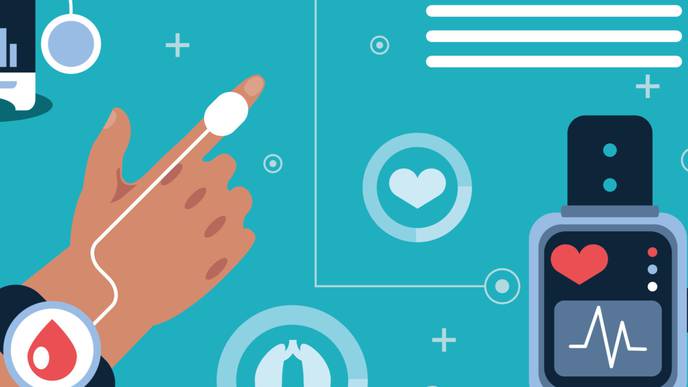COVID-19 Pandemic Changed Attitudes Toward Wearables

05/10/2024
To understand perceptions of wearables and identify the barriers to adoption, Cruz assembled a small group of low-income Hispanic and Latine adults in Chicago and Los Angeles. Participants met the low-income criteria if their income levels fell at or below the low-income threshold according to their county’s Department of Housing and Community Development.
After establishing a focus group, Cruz held two rounds of in-depth interviews between December 2021 and March 2022. In the first interviews, Cruz noticed that multiple participants made connections between COVID-19 and wearable devices. So, then she conducted a second round of interviews with more emphasis on using wearables for health monitoring. In these conversations, Cruz explored the participants’ opinions regarding wearable technology for health, their community’s perception of wearables and the features they would like to see in future wearables. She also asked participants about their access to Wi-Fi and other resource constraints.
Uncovering an overwhelming interest
Throughout the interviews, Cruz consistently found that the COVID-19 pandemic strongly influenced perceptions of wearable electronics. Participants who felt apathetic before the pandemic expressed a significantly increased interest in wearables for personal health monitoring and management.
About two-thirds of the participants in the study lost a close family member to COVID-19. Several of the participants also contracted COVID-19 before the vaccine and other treatments became available. These experiences made them realize how useful wearable health-monitoring tools can be.
“I guess the one thing that scares me that I never even thought of until I got COVID were my oxygen levels,” one participant said. “Like, am I at normal levels? Is that an issue that I need to kind of think about?”
“One thing I noticed, especially with COVID right now which is…the timing of getting all your vitals measured can actually save somebody's life,” another participant said. “So, I think that's a very important thing. Like oxygen levels to be measured.”
Alternative to in-clinic care
Participants also discussed difficulties when trying to access health care and how wearables could potentially compensate for the lack of local resources. Specifically, some participants shared how their neighborhood hospitals had closed, forcing community members to seek care at small, overcrowded clinics.
“It's overly populated. Even if you make an appointment, you're there all day,” one Los Angeles-based participant said. “Whatever time you go, whatever day you go, it's always crowded, because it's one of the very few [clinics] that accepts Medi-Cal. So low-income communities, they don't have the resources; it's always crowded.”
One participant highlighted that community members' lack of trust in doctors, coupled with high medical expenses, posed barriers to seeking medical treatment.
“Hispanic people don't go to the doctor because they don't believe in the doctor,” the participant said. “They think the doctors are gonna kill them and then they're poor, so they can't pay for the doctor. So, like if [a wearable] could do basic [vital] tests that would be great.”
Community-driven design
As a part of the interview process, Cruz asked participants what features and functions they desired in wearable devices. Cruz noted that oftentimes technologies designed for low-income groups do not take the intended users’ needs into account.
“If we are the ones that are supposed to wear the devices, then it makes sense to ask our opinions of how they can be incorporated into our daily lives,” she said.
In addition to wanting health monitoring capabilities (for heart rate, oxygen levels, blood pressure and more), the participants also desired enhanced affordability, control over the captured health data and increased durability. For wearables to be most effective, users must wear them continuously to capture consistent health data. This is where durability becomes a critical factor.
“I do think that it has to be very durable because the purpose is [for] low-income communities,” one participant said. “They don't have money to replace it. We just don't have comfy jobs. A lot of us work more physically demanding jobs. Some of us are plumbers, some are construction workers, some of us are gardeners. Some of us run a business and like that business involves pots and pans like we're restaurant workers. If [the device] breaks, they're just gonna say ‘oops’ and throw it away…If it is more durable that’s one of the biggest keys to wearing it.”
‘My community suffered a lot’
Although many people have moved on from the pandemic and resumed normal lives, Cruz said her community is still reeling. Cruz lost several family members to COVID-19 and hopes that designing more inclusive technologies can prevent future suffering.
“During COVID-19, my community suffered a lot,” Cruz said. “Some people have been able to brush it off and move on, but some of us are still scarred. We lost family members that probably would still be alive if they weren’t infected. Many people have long-COVID symptoms, which wearables also could help monitor. As these technologies get better at sensing vital signals, they also should become more inclusive.”
The title of the paper is “Perceptions of wearable health tools post-COVID-19 in low-income Latine communities.” Northwestern co-authors include Maia Jacobs, who is the Lisa Wissner-Slivka and Benjamin Slivka Professor of Computer Science at McCormick, and students Claire Lu and Mara Ulloa. Cruz is advised by study co-author Josiah Hester, who was an assistant professor computer engineering at Northwestern when the research launched. Now, Hester is an associate professor of interactive computing and computer science at Georgia Tech.

Facebook Comments